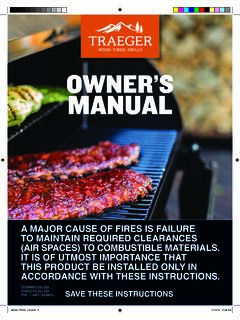Transcription of The Great Depression: California in the Thirties
1 The Great depression : California in the Thirties California was hit hard by the economic collapse of the 1930s. Businesses failed, workers lost their jobs, and families fell into poverty. While the political response to the depression often was confused and ineffective, social messiahs offered alluring panaceas promising relief and recovery. In spite of the general gloom of the decade, Californians continued to build and celebrate their Golden State. Hard Times Californians who lived through the 1920s and 1930s must have felt as though they were on a roller coaster.
2 In a dizzying cycle of boom and bust, a decade of spectacular prosperity was followed by the worst economic collapse in the state's history. Ramshackle encampments, such as Pipe City in Oaklafilled with forlorn unemployed workers and their families. The crash of the Macohelium-filled dirigible, mirrored the collapsing fortunes of Californians times of the Thirties contributed to a disturbing resurgence of nativism; authond, n, a The rities shipped thousands of Mexican ic ers created in California an "Okie subculture," a way of life still flourishing today.
3 Francisco General Strike of 1934 paralyzed the bay area and attracted national attention. Boom and Bustdeportees across the border. Meanwhile, thousands of new Dust Bowl refugees from the heartland of America streamed into California seeking a better life. Their coming inspired John Steinbeck to write The Grapes of Wrath (1939) and Dorothea Lange to compile an epic photographrecord. The newcomDiscontented workers in the Thirties went on the offensive. Farmworkers and farm owners locked horns in yet another round of total engagement.
4 The San onomic growth in California . Older industries expanded and new ones were founded. The decade of the 1920s was a time of booming ecBut the prosperity of the twenties was not well distributed. Proportionately, too much wealth was in profits and too little in wages. The income of many workers was so lowthat they couldn't afford to buy the products they produced. In other words, businesses produced more goods than could be consumed. This la rge supply of unsold products weakened the economy. The crash of the stock market in 1929 was followed by the worst rms and their homes.
5 Unemployment in the Golden State reached a staggering 28 percent in ears later one-fifth of all Californians were dependent upon public relief. depression in the history of California and the nation. Businesses and banks throughout the state closed their doors in the 1930s; thousands of individual investors and depositors lost everything. California farm income in 1932 sank to just half of what it had been in 1929. The number of building permits in 1933 was lessthan one ninth what it had been eight years earlier.
6 Many property-owners lost their fa1932; two yPipe City Thousands of unemployed workers and their families lived in makeshift encampmentsthroughout California in the 1930s. One such village was near downtown Oakland where out-of-work residents lived in huge concrete sewer pipes being stored above ground. Each six-foot section of concrete pipe became a "homeless shelter" for one of the neartwo hundred unemployed who lived there. Residents covered the ends of their pipes with burlap or cardboard, and survive ly d on mulligan stew made from discarded vegetables scavenged from nearby grocery wholesalers.
7 They called their village "Miseryville," but s in Pipe City were typical of what the homeless faced everywhere during the depression . The Oakland Post-Inquirer on December 3, 1932, offered the following rness, and the concrete may seem less hard and the blankets less thin and the mulligan less watery. But it takes a lot of philosophy, you bet, to make concrete either he Crash of the Maconthe press dubbed it "Pipe City." Conditionaccount: "To qualify for citizenship in Pipe City you must be jobless, homeless, hungry, and preferably shoeless, coatless, and hatless.
8 If one also is discouraged, lonely, filled with a terrible feeling of hopelessness and helplessness, one's qualifications are that much stronger . One belongs. Not all of Pipe City's inhabitants are that way. Some of them have learned that a philosophical attitude helps. One may tinge his philosophy with a drop of irony, even bittesoft or warm!" T igible, three times longer than a The world's largest aircraft ever was the USS Macon, a helium-filled, aluminum-framed dirBoeing 747. This "lighter-than-air" craft, built for the Navy in 1933, tipped the scales at just over 120 tons.
9 The Macon was returning home to Moffett Field on the San Francisco peninsula on tevening of February 12, 1935, when it was caught in a terrific rain squall off Point Sur. freakish gust of wind collapsed its upper tail fin, ripping holes in three of its helium ceThe huge airship quickly lost altitude and hit the water tail first. The mist-shrouded wreckage floated just long enough for all but two of its crew ohe A lls. f eighty-three to escape. With its nose pointing skyward and a mournful sigh of helium gasping from its open rosperous Californians.
10 Their collective epitaph was supplied by the radio operator of the Macon on that fateful evening in 1935. ry bulk dipped toward the sea at twilight, a single word flashed through the storm clouds off Point Sur: "Falling." wounds, the Macon slowly slipped beneath the waves. "She soared in her death throes," wrote one local journalist, "and was lost to view in the mist." The crash of the Macon was an event of symbolic importance. Its fate seemed to mirror the declining fortunes of millions of once pAs the Great silveDeportees Xenophobia and nativism experienced a resurgence during the Great depression .














